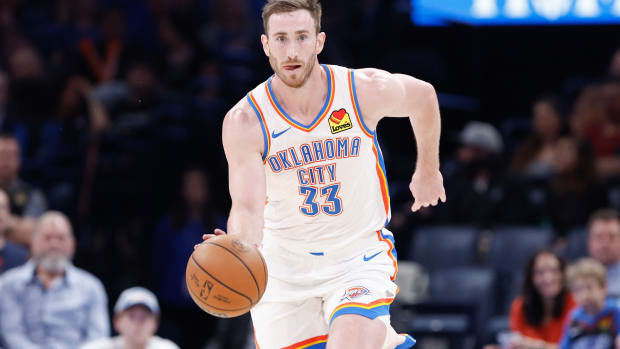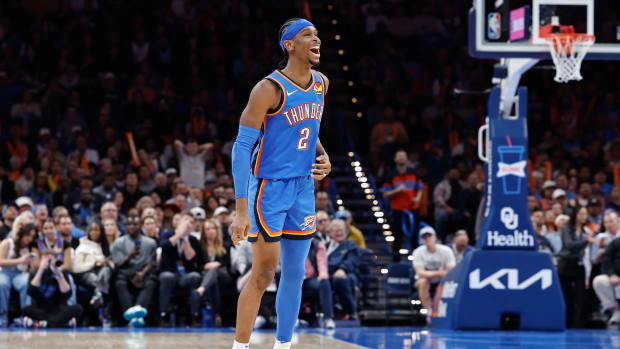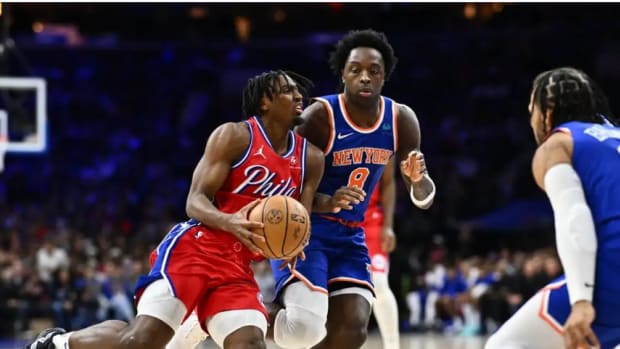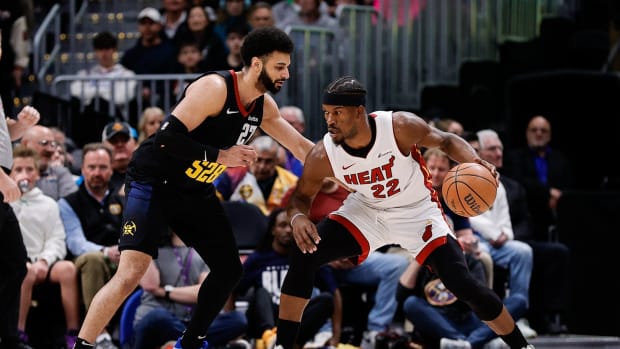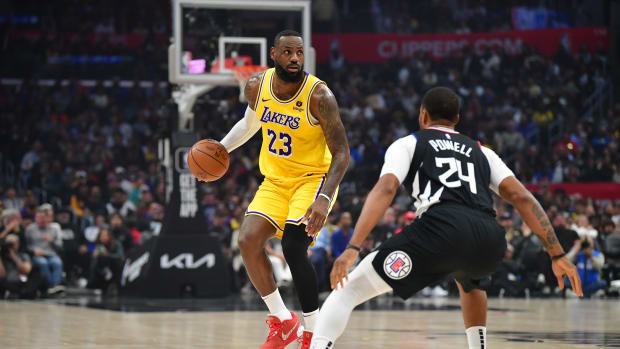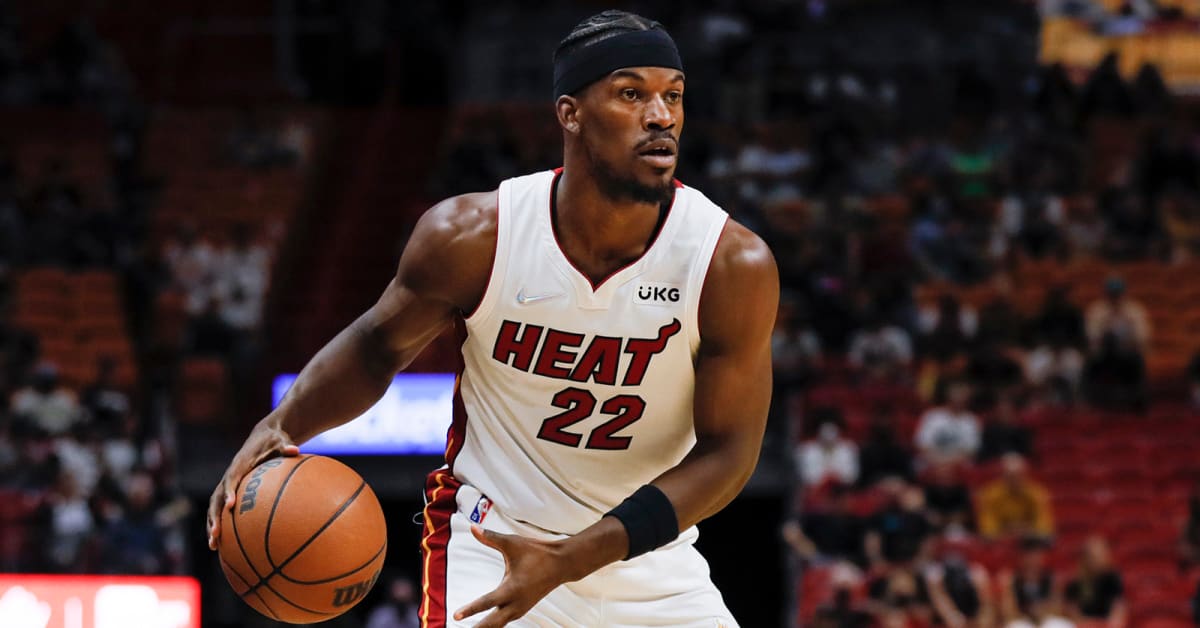
Six Burning Questions for the Heat
Before Monday night’s pseudo-reassuring 123–100 win over a Kings team that didn’t have Domantas Sabonis or De’Aaron Fox, the Heat were stuck in a poorly timed free fall.
In between recent losses against the Sixers (without James Harden and Joel Embiid) and Knicks (without Julius Randle), last week Erik Spoelstra threw his clipboard in Jimmy Butler’s direction, a public meltdown that occurred during the third quarter of a game in which they had no answer for Warriors guard Jordan Poole. (Steph Curry, Draymond Green and Klay Thompson did not dress.) Then on Saturday, they were obliterated at FTX Arena by the Nets, at one point trailing by 37 points, their largest deficit of the season.
Every team goes through ups and downs during an 82-game regular season, and while this stretch doesn’t prohibit the Heat from winning it all (they’re still in first place!), it does illuminate a few glaring questions that, one way or another, will be answered in the playoffs. Here are the most important.
Will Their (Theoretical) Best Lineup Actually Play Together?
Kyle Lowry, Bam Adebayo, Jimmy Butler, Tyler Herro and PJ Tucker is, on paper, a complementary juggernaut that’s built to close a Game 7. In reality, these five players have only combined for 51 minutes together. Their net rating as a five-man unit is -11.14.
There’s a way to look at this with a silver lining. Opposing coaches have only a few games worth of tape to study and, in an abstract sense, Miami’s ceiling is higher than anything we’ve already seen if/when this group clicks—which, it should?
The talent is undeniable. Butler, Adebayo and Lowry are a positional perfect fit. Tucker is still one of the better role players in the league—especially during a season when he’s drilled a career-high 41.4% of his corner threes—and Herro’s off-the-bounce dynamism pushes the other four to a higher level. He can draw attention roaming on the weakside, run his own pick-and-roll, and fly into a dribble hand-off that collapses the defense and creates an open shot elsewhere. In the playoffs, he’s also able to create space in the mid-range as a good-not-great high-volume pull-up shooter.
Here he is setting Tucker up for an open corner three off a stagger screen with Butler and Adebayo:
The pick-and-roll combinations between almost everyone in this group are interchangeable: Lowry and Butler can screen for each other, same goes for Butler and Bam, Bam and Lowry, Herro and Bam, Butler and Herro. In a playoff series, weak defenders will guard Tucker. But that’s no picnic. He crashes the offensive glass, can playmake as the screener in a middle pick-and-roll as a release valve and must be accounted for when spaced out along the perimeter. Lose focus and Tucker will sprint into a back screen or, as can be seen on the play below, run a couple quick dribble handoffs that eventually produce a three for one of Miami’s ensemble of dangerous shooters:
There’s reason to be optimistic about the damage this lineup can inflict in the postseason. But against some of the more cohesive teams in the league, teammates who’ve fought innumerable crunch-time battles together, it’s so hard to know if they’ll all be on the same page offensively, or offset the group’s lone individual question mark on defense. Speaking of …
How Important is Tyler Herro?
Herro is going to win Sixth Man of the Year. He’s averaging a fairly efficient and sleek 20.8 points per game and leads Miami in usage rate and shots—details more commonly found on an All-Star’s resume than someone who comes off the bench. Herro is making 38.9% of his threes and 49.5% of them when wide open (which is fourth-most accurate out of 164 players who’ve taken at least 100 such shots).
There’s a case to be made for him as Miami’s third-best player, but doing so would overlook all the sacrificial and improvisational ways Lowry makes life easier for everyone around him. Also: defense. Herro is that individual defensive question mark mentioned above. Down the stretch of last week’s loss in Philadelphia, Doc Rivers instructed his team to hunt him on pretty much every possession.
Herro’s defense isn’t atrocious on the play above—it’s Max Strus losing track of his man along the baseline that leads to Miami’s breakdown—and he’s held up well enough on switches all season. But the playoffs are a different animal. Shake Milton won’t be who he’s on an island against, and Bam can’t do everything.
(“We just gotta guard our yard,” Adebayo recently said when asked about how opponents go out of their way to avoid him in crunch time. “We gotta take the challenge one-on-one.”)
As important as Herro’s crafty shot-making is to Miami’s uninspired offense, if he can earn Spoelstra’s trust in the playoffs and guard his yard when it matters most (i.e. allow the Heat to switch ball screens—without over helping—and induce inefficient iso-heavy offense) then that five-man group that may be this team’s crunch-time salve can really thrive.
Now, about that uninspired offense …
So, Miami’s Offense?
For the season, Miami ranks 12th in offensive rating, smack dab in between the Bulls and Sixers. Before the All-Star break they were eighth. Since, they’re 16th. Given how much turmoil Miami has endured—from Bam’s thumb surgery to Butler’s myriad injuries to the 13 games Lowry missed due to personal reasons—with a roster that’s had to integrate a couple new starters while facilitating in-house development from the likes of Herro and Adebayo, the Heat’s offensive concerns are understandable. (It’s their elite defense that better explains why they’ve spent 48 days in first place.)
That doesn’t mean they aren’t a big problem, though. In the 600 minutes Adebayo, Butler and Lowry have shared the floor, Miami’s offensive rating is 110.5 (or about as efficient as the 20th-ranked Cavaliers).
Overall, it falls to 108.2, aka 24th place, in the fourth quarter. In March, they’ve been a disaster. Against the Knicks their offensive rating in the fourth quarter was 65.2. Against the Suns it was 69.6. Against the Thunder it was 70.8 (in a convincing win). Against the Timberwolves it was 72.0. Against the Bucks it was 88.0. (Their defense late in games has also been getting set on fire lately.)
Some of these numbers can be cleared up by Butler or Lowry not being available. But that’s kinda the point. Miami’s Big 3 has played only 104 fourth-quarter minutes together this season. Over that span the Heat’s offensive rating is a listless 106.8. (As a whole, their crunch-time offensive rating is 98.4.)
It’s honestly hard to understand why a team with so many players who can shoot, pass and drive has struggled to generate efficient late-game offense. But some of their struggles can be explained by a tepid pace. In high/very high leverage situations (an explainer on what that means can be found here), they average 16.8 seconds per offensive possession. Only the Raptors, Mavericks and Cavaliers are slower. They’re 29th in pace after a miss at the rim and 22nd in points per possession on those plays. This isn’t great.
For the entire season, roughly one out of every five shots taken by the Heat is with seven or fewer seconds on the shot clock. This hasn’t been a serious problem (they lead the league in effective field goal percentage on attempts launched “late” in the shot clock by NBA.com) but when you zoom out and look at their entire offensive identity, it may portend issues in the playoffs for a team that has some questions about how effectively they score the ball.
Lowry’s full-court hit aheads and Adebayo’s coast-to-coast expeditions do what they can to speed things up, but those aren’t options to rely on. A faster pace isn’t required for Miami to get where it wants to go, but wouldn’t hurt when considering how lethargic, mistake-prone and predictable they can be executing in the half court. (The Heat lead the league in dead-ball turnovers per 100 possessions and step out of bounds more than any other team.)
When they went to the Finals two years ago, the Heat boasted a half-court offense that was more efficient than any from the LeBron James era. It was third best in the league. Now they’re average, particularly reliant on free throws and accurate three-point shooting.
This section was initially titled “Will Miami’s Threes Fall (And Can They Generate Enough Good Ones?)”. Given that they make a league-best 37.4% of their threes, the Heat could stand to take more than they do—they rank 11th in three-point rate. But they are excellent at creating quality looks from the corners, where they make a league-high 4.6 per game. Only the Bulls are more accurate, and no team has a higher corner-three frequency, according to Cleaning the Glass.
Shifting their shot selection to the perimeter is easier said than done, considering Adebayo doesn’t take any threes and Butler prefers not to (though maybe he should). Speaking of Jimmy …
Can Jimmy Butler Be Who He Was in the Bubble?
The 2020 postseason was the peak of Butler’s career; the Finals were a perception-changing breakthrough. Against the best defense in the league, he averaged 26.2 points, 9.8 assists and 8.3 rebounds, logging two triple-doubles, guarding LeBron James and basically never getting to rest (from Game 2 until Game 6 he averaged 45 minutes). On the sport’s grandest stage, Butler pushed himself to a level few thought he would or could ever reach.
It's wrong to expect that type of production for a long period—especially from someone who approaches each possession looking to make the correct play and was pretty awesome during the 2020–21 regular season—but we haven’t really seen that Butler since he exited the Bubble. And, even though injuries to Goran Dragic and Adebayo at the start of the ‘20 Finals forced Butler to reach deep inside himself in a way this year’s team doesn’t demand, it’s worth asking if, at 32 years old, he’s capable of singlehandedly masking Miami’s aforementioned offensive issues in a similar way.
The answer may very well be “yes!” After completely disappearing in last year’s playoffs, Butler is still awesome, a floor-raising, do-it-all beacon of selfless, smart physicality who is masterful at drawing fouls and can handle himself on just about any assignment in a switch-everything defense. (Among those who’ve played at least 1,000 minutes, Butler is third—behind Joel Embiid and Giannis Antetokounmpo—in on/off differential that pertains to free-throw rate.)
In the playoffs, it’ll be interesting to see how aggressive Butler will be—he’s isolating more this year than any regular season in his career, according to Synergy Sports—and whether the Heat will lean on him even more than they already do, hunting mismatches out of ball screens as the handler and picker, as seen on the play below.
That basket is just a slice of all the different ways Butler can positively impact an offense—on ball, off ball, moving at his own off-kilter tempo, out-muscling wings and guards in the post, etc.—but there may be a point where Miami ultimately needs him to carry a heavier scoring load than he’d prefer. Unless …
Can Bam Be Miami’s Best Offensive Player?
At some point, Adebayo will emerge as Miami’s undisputed best player. That day might already be here, as a full-blown Defensive Player of the Year candidate who allows Spoelstra to flow from one scheme to the next without hesitation. The Heat can blitz, switch (which they do a ton), drop or deploy a zone because Bam guards all five positions, bottles up elite wing scorers, boxes centers out of the frame and smacks would-be-floaters off the glass. It’s disruption on a scale few can match.
“To do what we’re doing requires a unicorn. That’s what Bam is defensively,” Spoelstra has said. “He can defend in any scheme and he can defend any player within that scheme.”
Adebayo’s value is clear on that side of the ball. Why can’t the same be true when Miami has possession? Despite averaging a career-high 19.1 points with a career-low 60% of his baskets coming by way of an assist, it still feels like Adebayo can and should shoulder a larger role on offense. His mid-range jump shot has taken a dip this year, but as someone who draws a ton of fouls and is either quicker or stronger than whoever’s trying to guard him, Adebayo may be able to help some of Miami’s offensive woes in a playoff series.
Understanding that Butler, Lowry and Herro are on his team, Adebayo’s 23% usage rate in the fourth quarter is a crime. And it may be to Miami’s benefit if he had a larger hand in dictating consequential offensive possessions in the playoffs. So here’s to watching him impose his will, surrounded by shooters, as long as the Heat are alive:
And if more shots and touches from Adebayo aren’t the answer, there’s a very small but not impossible chance they find it from another source …
Will Victor Oladipo Be In the Rotation?
It’d be extremely convenient if the Heat had a version of Oladipo who was even 80% what he was five years ago: An explosive combo guard who could drill pull-up threes and turbo boost his way toward graceful buckets at the rim seemingly whenever he wants without getting targeted on defense. That player, of course, wouldn’t cost the veteran’s minimum. But he’d still be ideal for a roster that may ultimately need one more dynamic two-way option at the end of close playoff games.
Oladipo has played in six games this season; his debut earlier this month came after a 333-day interruption that was caused by a quadricep tendon that he tore for the second time in as many years. Unsurprisingly, he looks exactly like someone coming back from a serious injury should. He is settling for jump shots (that aren’t going in) and doesn’t have the same ability to accelerate, stop and then speed up again like he once did. Oladipo’s body and mind just aren’t there yet.
He’s missed about half his shots at the rim and caught a DNP in Monday’s win over the Kings, as Strus replaced Duncan Robinson in the starting five. It’s probably the most minor issue Miami faces right now, considering how successful they’ve been without Oladipo all year, but they’d be so much more dangerous than they already are if he was a solid contributor off their bench.
More NBA coverage:
• The Inevitability of Cade Cunningham
• Joel Embiid: 'I Thought I'd Lose It'
• LeBron, Lakers Better Off Not Reaching Play-In






























